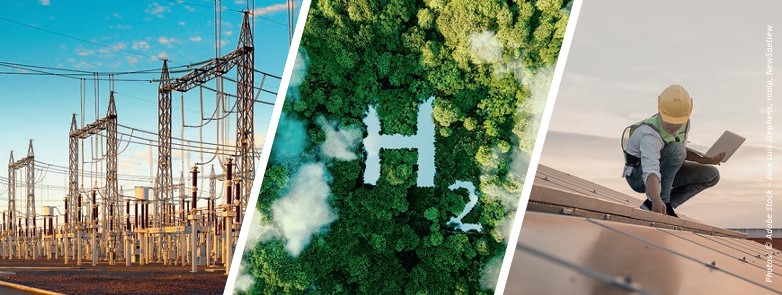June 16-17, 2022
London, UK
This Forum addressed the integration of biodiversity and nature’s benefits to people into decision-making, systemically and globally. The Forum focused on the grand challenge of valuing, sharing, and regenerating the benefits of nature; models of success today; barriers to adapting, replicating, and scaling these models in science, capacity, social innovation, and institutions; and key opportunities for lifting these barriers and transforming to nature-positive, climate-smart, and inclusive systems and pathways for sustainable development.
Session 1: The Grand Challenge
Chair: Eric Lambin
This session set the Forum’s general agenda, outlining the crisis resulting from not incorporating the multiple values of nature into decisions – in policy, planning, finance, and operations – and how to seize the new moment of opportunity at hand.
Welcome and Overview of the Scope and Structure of the Meeting
Speaker: Yadvinder Malhi

Opening Keynote: Bringing Nature into Decision-Making: A Brief History and Our Challenge Today
Speaker: Gretchen Daily

Reflections and Discussion
Speaker: Eric Lambin

Interdependence of Civilization and the Living World in the Anthropocene
Speaker: Carl Folke
Human actions have become a major force in shaping the future of the Earth system. In the Anthropocene, people and nature are dynamically intertwined and embedded in the biosphere, with shocks and extreme events as part of this dynamic. The Anthropocene reality – of rising system-wide turbulence – calls for transformative change towards sustainable futures, where stewardship of the biosphere foundation is essential for a prosperous development of civilization.

Valuing Nature: The Case of Tropical Forests and Costa Rica
Speaker: Alvaro Umaňa
This talk focuses on the failure to account for the value of standing tropical forests, and ecosystem services in general, in economic decision-making. This has led to overuse, exploitation and habitat destruction, as well as a significant contribution to greenhouse gas emissions. Forest carbon also has a critical role in the fight against climate change and has additional benefits in terms of biodiversity and water. The case of Costa Rica is analyzed briefly.

Incorporating Nature-Related Risks and Opportunities in Financial Decisions – The TNFD Framework
Speaker: Emily McKenzie
The Dasgupta Review on the Economics of Biodiversity showed we have collectively failed to engage with nature sustainably. One important route for change is to transform our finance system. The Taskforce on Nature-related Financial Disclosures (TNFD) is helping to address this by developing a risk management and disclosure framework for corporates and financial institutions to report and act on nature-related risks and opportunities.

Session 2: Key Concepts Part 1
Chair: Unai Pascual
This session addresses the key conceptual foundation for, and debates around, how nature is valued and represented in decision making processes, by whom and with what consequences.
Introduction
Speaker: Unai Pascual

Nature’s Contributions to People – New Insights at the Environmental Science-Policy Interface
Speaker: Sandra Díaz
The ways in which the links between societies and nature are conceived have changed dramatically over the past few decades. This has deeply influenced the international science-policy interface on biodiversity. The notion of nature’s contributions to people ̶ part of the inclusive conceptual framework increasingly being used by intergovernmental bodies to address the links between nature and society ̶ is possibly one of the best illustrations of this process. The transdisciplinary and action-oriented concept of nature’s contributions to people embraces the diverse ideas about what people derive from, and co-produce with, nature. It facilitates plural valuation of nature and both its benefits and detriments, and enables diverse actors to represent nature-people interactions for different scales, audiences, and decision-makers. The talk will summarize major features and history of the concept, dispel some common misconceptions and discuss what it is bringing to the environmental science policy interface.

Ecosystem Services, Climate Change and the Environmentalists’ Paradox
Speaker: Sharad Lele
The latest Intergovernmental Science-Policy Platform on Biodiversity and Ecosystem Services (IPBES) report warns us of a rapid decline in biodiversity. The Ecosystem Services framework suggests that this will seriously affect human well-being. But policy-makers do not seem to respond with any great alacrity to these warnings. Some skeptics even point to rising human well-being as an indication that the claims linking nature and well-being are exaggerated. This is the Environmentalists’ (or rather Conservationists’) Paradox: rising well-being but declining biodiversity. How does one resolve this? And where does the ‘mother of all environmental problems’ i.e., climate change, figure in this picture? This talk offers a broader framework of the Nature-Society relationship, one grounded in ecological economics and political ecology. This framework helps us resolve the paradox and include climate change, but then asks us to think differently about solutions.

Valuing Nature in Decision Making – the Power and Limitations of Economics
Speaker: Steve Polasky
Public and private decision-making around the world are driven by economic metrics such as GDP and financial rates of return. These metrics provide useful information but have a major flaw: they fail to incorporate the value of nature and therefore fail to provide adequate incentives to conserve nature. Reliance on economic metrics has led to rapidly rising GDP, large private returns, and to a climate and biodiversity crisis. This problem can be addressed by incorporating the value of natural capital and the ecosystem services it generates into economic accounts. Many efforts to do so are currently underway and are spreading into the mainstream of government and business operations. However, major challenges remain including valuing “non-market” goods and services, giving proper weight to values and viewpoints antithetical to market-oriented thinking, addressing equity, fairness and the rights of indigenous peoples and future generations, and accounting for the intrinsic value of nature.

Keynote Address: How Science Can Deliver More for Forest Conservation – a Practitioner’s View
Speaker: Tom Evans
Good evidence, delivered in the right way at the right time, can play a pivotal role in societal decisions around forests, but too often that doesn’t happen. With examples from major current debates in forest policy and conservation practice, Dr. Evans highlights some of the ways this could be changed for the better.

Session 2: Key Concepts Part 2
Chair: Anne Christianson

Bringing Nature into Decision Making: Conceptual Framework
Speaker: Ian Bateman
The concept of ‘natural capital’ is gaining traction internationally as recognition grows of the central role of the natural environment in sustaining economic and social wellbeing. It is therefore encouraging to see the first signs of a ‘natural capital approach’ to decision making being accepted within government policy processes and the private sector. However, there are multiple different understandings of this ‘approach’, many of which misuse or omit key features of its foundations in natural science and economics. To address this, we present a framework for natural capital analysis and decision making that links ecological and economic perspectives. We illustrate the power of this approach by contrasting it with conventional market-based solutions to environmental resource challenges.

Valuing Nature through a Human Health Lens
Speaker: Kathy Willis
Over the past few decades there has been a large global increase in the incidence of non-communicable diseases (NCD), including cardiovascular and respiratory diseases, cancers, and mental illnesses. These conditions kill up to 41 million people each year, equivalent to 71% of all deaths globally (WHO 2021). Over the same interval of time, a scientific evidence-base has emerged to demonstrate that interacting with certain aspects of nature can provide a complementary treatment for many of these NCDs and associated symptoms. This talk discusses these studies, looking at which interactions with nature (sight, smell, sound and touch) are linked to positive health outcomes. It also examines evidence for their efficacy and economic value compared to conventional treatments.

Session 3: Science and Social Innovation for Transformation: Models of Success & Challenges to Scaling
Chair: Carter Brandon
This session explores some of the world’s most inspiring models of success operating at significant scale. We’ll explore contrasting ecosystems and economic sectors and culminate with an approach designed to integrate across all ecosystems and their benefits to people. How did these cases develop, and what is the potential for scaling them much further?

Nature-Positive Approaches to Coastal Climate Resilience: Innovating and Scaling across Latin America and the Caribbean
Speaker: Mary Ruckelshaus (featuring work by Chantalle Clarke-Samuels)
Awareness of human dependence on nature is at an all-time high, the science of ecosystem services is rapidly advancing, and talk of natural capital is now common from governments to boardrooms. Here we illustrate paths through which ecosystem service information is moving beyond ideas to action in coastal zones, through: (i) providing evidence linking cross-sectoral decisions to impacts on natural capital and multiple benefits, including resilience to sea-level rise and storms and bolstering tourism and fishery livelihoods; (ii) co-developing with leaders the tools and practices needed for everyday decision-making; and (iii) reforming investments, policies, and institutions. Examples from Belize and other Caribbean countries illustrate how human wellbeing can improve by identifying communities at greatest risk, and harmonizing tourism, fisheries and other objectives. With support from the Inter-American Development Bank, implementation of spatial development plans is leading to targeted biodiversity and ecosystem financing and greater coherence of policies across sectors.

Seafood Business for Ocean Stewardship (SeaBOS)
Speaker: Henrik Österblom
The biosphere crisis requires changes to existing business practices. We ask how corporations can become sustainability leaders, when constrained by multiple barriers to collaboration for biosphere stewardship. We describe how scientists motivated, inspired and engaged with ten of the world’s largest seafood companies, in a collaborative process aimed to enable science‐based and systemic transformations (2015–2021). Co‐creation of solutions resulted in new knowledge and trust, a joint agenda for action, and convergence of corporate change.

Vicuñas: Intercultural science, for a Biocultural Path to Sustainability
Speaker: Bibiana Vilá
South American Camelids (SACs) make several contributions to people and are a key component of the Andean biocultural heritage. Vicuñas (Vicugna vicugna) have one of the finest (12 microns) and expensive (400 US dollars/ kilo) natural fibres in the world. Vicuñas were at risk of extinction due to hunting. International and regional conservation, as well as the will and care of indigenous communities saved the species. Sustainable harvest of vicuña fibre is achieved by “chakus”,
capture and live-shearing. The raw fibre prices are falling. We are now exploring the possibility of making high-quality artisan garments to add value and generate a sustainable option for locals. We present a detailed description of the production of a shawl. The handwork has been economically recognized, and costs calculated. The final cost of the garment was approximately 3,300 dollars and half of this cost was the dehairing and cleaning of the fibre.

Cities in Nature: Singapore
Speaker: Lena Chan
The talk illustrates how the National Parks Board of Singapore (NParks) identifies problems, crafts specific problem statements, works with the scientific community to design research projects that seek nature-based solutions, interprets the data, translates the results to policies, operationalises the recommendations on the ground and devises evaluation and monitoring programmes – all in one government agency collaborating in an interdisciplinary manner and comprehensively with multi-governmental agencies, academic community, and the public (NGOs, citizen scientists, etc.). It also highlights initiatives that can help upscale models of success on biodiversity conservation in cities.

Using Gross Ecosystem Product (GEP) to Mainstream Nature into Economic Decision-Making
Speaker: Tong Wu (featuring work by Zhiyun Ouyang)
Measured by Gross Domestic Product (GDP), the global economy grew significantly in recent decades. However, the world’s natural capital and corresponding flows of ecosystem goods and services continued to decline. Gross Ecosystem Product (GEP) can help reconcile these divergent trends by mainstreaming nature into economic decision-making. GEP was first implemented in China, but it has begun to attract international interest, gaining wider legitimacy through endorsement and support by the United Nations and other multilateral institutions.

Participant Discussion: What are the challenges in bringing nature into decision-making, and who makes the decisions?
Discussion leaders: Anna Armstrong and Brad Wible

Keynote Address: How the Global Environment Facility Brings Nature into Decision Making
Speaker: Carlos Manuel Rodríguez
Session 4: Driving Transformation: Scaling Success and Opening New Frontiers
Chair: Rosina Bierbaum
This session explores the role of political and economic actors with the power to encourage or require greater adoption of decision-making processes that value nature.

Nature Based Solutions for Climate Change Adaptation in Colombia
Speaker: Angela Andrade
This talk highlights the main achievements in adaptation to climate change in the high mountains of the region surrounding the city of Bogotá, in Colombia, the main lessons learned, and future challenges.

Integrating Natural Capital into the Financial Sector through Multilateral Development Banks, as Pledged at CoP26
Panel discussion with Fiona Stewart and Robert Schoellhammer moderated by Kathy Segerson)

Nature Finance Insurance and the Built Environment
Speaker: Frank Nutter
Nature in the form of extreme events punishes the built environment and yet can serve to protect it when the built environment utilizes it properly. Insurers and their policyholders are exploring incentives to achieve hazard reduction via natural mitigation measures.

Private Financial Sector
Speaker: Gim Huay Neo

Building the Private Sector Accountability Mechanism on Nature
Speaker: Timothée Pasqualini
The urgency for the private sector to act decisively and transform its links with nature has never been so clear. Holding companies accountable for their action on nature and biodiversity is therefore critical. The World Benchmarking Alliance is playing its role as an accountability actor thanks to its Nature Benchmark, which is assessing how over 1000 influential companies from 22 industries are contributing to a nature-positive future that leaves no one behind.

Data Needs and Gaps for Integrating Nature into Investment Decisions
Speaker: Harun Dogo
Integrating nature into investment decisions requires actionable information about the footprint and impact of a specific investment in an easily accessible, rapid, and scalable manner – a task that is currently quite challenging, but may be simplified with the next generation of tools and datasets.

The Law as a Lever to Deliver Change
Speaker: Gillian Lobo
The presentation addresses how the law can help increase transparency in decision-making by providing for access to information in environmental matters.
Session 4: Participant Discussion

Session 5: Synthesis Session
Discussion leaders: Gretchen Daily and Yadvinder Malhi; rapporteurs: Bob Litterman, Joseph Lowe, and Rebecca Shaw
This session includes all Forum attendees and draws together the key conclusions from the presentations and exchange to help formulate a number of pragmatically oriented action items that will serve as a foundation for further collaborative work.

Session 6: Paths Forward for Embedding Nature in Decision Making
Reflections
Speaker: John Holdren

Closing Keynote: Collective Action for a Nature-Positive, Climate-Smart, and Inclusive World
Speaker: Aileen Lee
Over two days, the US-UK Scientific Forum on Bringing Nature into Decision Making brought together leading scientists with key actors from across the policy, civil society, development bank, public and private donor, business, and financial sectors. This talk builds on insights from the workshop and highlights opportunities for collective action across sectors to advance our shared goal of catalyzing a systemic shift in how the benefits of nature are valued and integrated.

Related Events
Event Disclaimer
It is essential to the National Academy of Sciences mission of providing evidence-based advice that participants in any of our meetings or events avoid political or partisan statements or commentary and maintain a culture of mutual respect. The statements and presentations during our meetings or events are solely those of the individual participants and do not necessarily represent the views of other participants or the National Academy of Sciences, which is a non-partisan, tax exempt organization.


